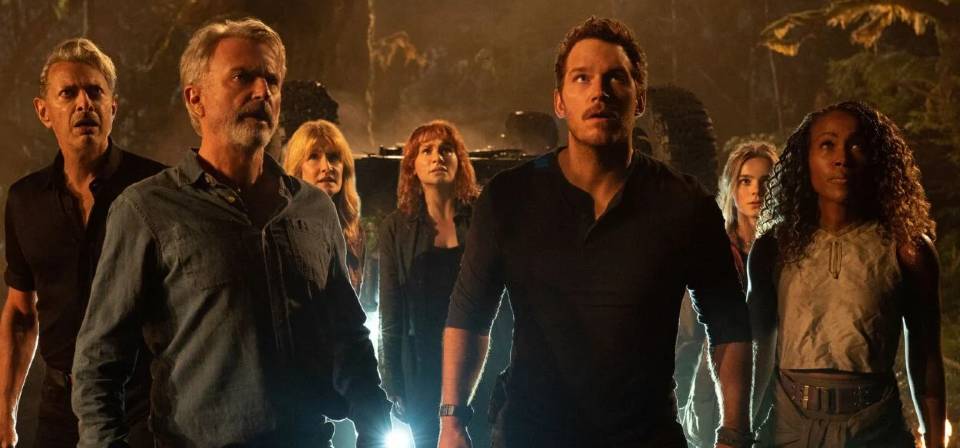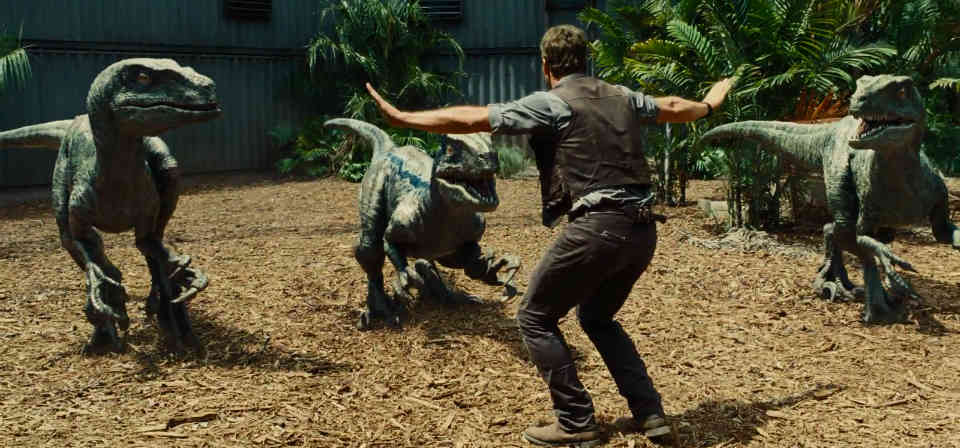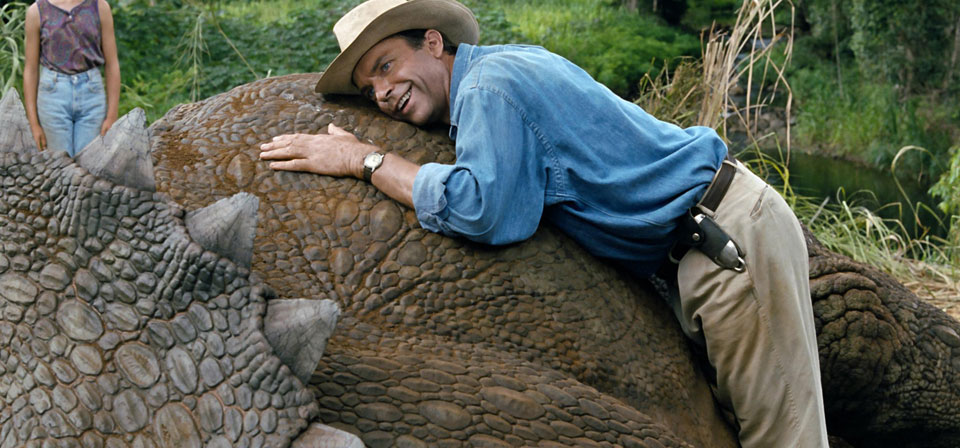Jurassic World: Fallen Kingdom (2018)
Jurassic World: Fallen Kingdom runs two hours and 10 minutes, and if you bracket the first five minutes and the last five minutes, any random five minutes in the remaining two hours are probably more enjoyable than any random five minutes of the previous Jurassic World movie, and probably any five minutes of Jurassic Park 3.
There are images worth looking at, for one thing. Visually, not much from Colin Trevorrow’s 2015 Jurassic World has stuck with me beyond Chris Pratt holding three velociraptors at bay with hand signals and steady nerves (and later absurdly cruising alongside the raptor pack on a motorcycle).
Caveat Spectator
Much intense menace and stylized dinosaur-related violence, including a number of deaths; some cursing and brief profanity.J.A. Bayona (The Orphanage; The Impossible) has a better eye and a gift for atmosphere and creates painterly, sometimes powerful images. He also displays a Spielbergian gift for pushing the audience’s buttons. I jumped and laughed repeatedly, sometimes in the same five minutes.
As the five-minute stretches pile up, though, the movie goes back to the same tricks too often. The “bigger fish” trope is used at least twice too often, and the kitchen cabinet door from the first film becomes a dumbwaiter door here that is used repeatedly.
Eventually, all those five-minute stretches add up to two hours and 10 minutes that have to tell some kind of story that ought to be about something. Fallen Kingdom is a “fivequel” (or, if you prefer, a middle movie in a sequel trilogy) with nothing to say and no case for its own existence beyond brand momentum and the employability and photogenic looks of Pratt and Bryce Dallas Howard.
If Fallen Kingdom did have something to say, it might be about environmentalism and exploitation of nature. After the disastrous collapse of the new Jurassic World theme park (and hundreds of millions of dollars in settlements), the dinosaurs of Isla Nublar are on their own — and facing extinction from the island’s volcanic activity (a plot point going back to the original Michael Crichton novel, so we can’t ding the filmmakers for it).
This makes the dinosaurs objects of considerable preservationist concern and action. Howard’s character, Claire Dearing, now a crusading conservationist, might as well be a different character from the buttoned-up sexist stereotype of the first film (she’s closer in spirit to her park ranger in Pete’s Dragon).
Claire and Pratt’s one-time raptor trainer Owen Grady are no longer an item, but she manages to persuade him to join her on a rescue mission to Isla Nublar, accompanied by an anxious tech wizard (Justice Smith) and an ex-Marine paleoveterinarian (Daniella Pineda). To be clear, the mission is to rescue dinosaurs — a mission that occasions some debate, as well it might.
Unlike other endangered species, dinosaurs play no integral role in the balance of an ecosystem, nor are they valued by preservationists for their biodiversity (only the villains talk about the dinosaurs as resources). Instead, Claire’s brief for the dinos rests on human appreciation and empathy: We like seeing dinosaurs and they are living, breathing creatures that deserve our respect and compassion.
Neither consideration is without merit, though the waters are muddied by talk of “dinosaur rights.” (In Catholic moral thought, human beings have moral obligations regarding animals and owe them kindness, but animals lack by nature the capacity for moral agency and responsibility and thus are not properly subjects of “rights.”)
Backing for the mission comes from Sir Benjamin Lockwood (James Cromwell, affecting a British accent and an unwonted joviality), an old business partner of (and stand-in for) the late Richard Attenborough’s John Hammond. Cromwell’s household includes his unscrupulous right-hand man Eli Mills (Rafe Spall), his stern housekeeper Iris (Geraldine Chaplin) and his young granddaughter Maisie (Isabella Sermon), on hand to be this movie’s spunky menaced child.
Where the last film’s ruthless paramilitary figure was played by Vincent D’Onofrio in low-rent Brian Dennehy mode, this time we’ve got Ted Levine in low-rent Woody Harrelson mode. (Both D’Onofrio and Levine have much more interesting modes, so the slight is to the film, not the players.)
None of these characters is more than one-dimensional. Claire and Owen were one-dimensional characters in the first film, but now that Claire’s not an ice queen and Owen is at least less of a sexist jerk, I’m not sure they have even one dimension.
Jeff Goldblum’s Ian Malcolm is on hand, barely, to testify about the inevitable consequences of human irresponsibility. This sets up a contradiction at the heart of the drama that the filmmakers have no idea how to solve.
The dinosaurs can’t be contained on Isla Nublar or anywhere else. Not only does life always find a way, unscrupulous human efforts to exploit the dinosaurs will always offer the dinos opportunities to break free. Realistically, dinos are an unpredictable hazard not only to human beings but to whole ecosystems.
Yet our heroes love the dinos and want them to live — and the longer the franchise wears on, the more the movies love the dinos too, even if the “oo” and “ah” always gives way to running and screaming.
Of course even reconstituted dinosaurs ought to be treated humanely. At the end of the day, though, if it’s them or us, there’s only one right answer, and the movie seems to struggle with that. One line even seems to suggest that what dinosaurs really need is for humans to get out of the way.
Perhaps I’m thinking about this too hard, or perhaps the writers should have thought harder. Certainly the plot is one utterly predictable development after another (most of which my 15-year-old daughter actually predicted as the movie unfolded).
The last movie featured a genetically engineered hybrid supersaurus called Indominus Rex, a powerful, intelligent amalgam of T-rex and other species, most ominously including velociraptor. It was supposed to be ominous, anyway; I found it a lame reveal, since I had assumed that of course raptor DNA was in the mix and wondered whether the intelligence might reflect a more transgressive choice to mix in mammalian DNA, possibly even human.
Now they’ve got an even smarter, more advanced designer dino called an “Indoraptor,” a hybrid based on Indominus Rex, but with, you know, more raptor. What’s next, “Velocindoraptor”? Apparently velociraptor is the cowbell of dino design and the filmmakers are Christopher Walken. How is the imaginative scope so limited?
What makes this even weirder is that the Fallen Kingdom throws in some unrelated transgressive science involving human DNA, seemingly at random and with no connection to the main dinosaur theme. This goes nowhere and does nothing, at least in this movie. (Spoiler alert: The science in question involves human cloning.)
The first five minutes are soured for me by a particularly cruel killing of a random character overtly recalling a far crueler killing in the previous Jurassic World. (I assume this is cowriter Colin Trevorrow tipping his hat to himself.)
The last five minutes crash and burn completely as the heroes struggle with doing something unthinkable before taking a head-smacking cop-out to get the ending the movie wants, which is not actually the ending this movie wants, but the ending the next movie wants.
This is, more and more, the new normal in the evolution (or re-engineering) of Hollywood blockbusters. As audience expectations adapt, third acts and resolutions are becoming optional. Jurassic World: Fallen Kingdom is what a movie looks like when the goal is less to send viewers home satisfied than to send them home anticipating the next movie, which is not the same thing.
Related

Jurassic World Dominion (2022)
The word “dominion” is uttered once in Jurassic World Dominion, in an oblique, irreverent allusion to Genesis 1. “Not only do we lack dominion over nature, we are subordinate to it,” asserts Dr. Ian Malcolm (Jeff Goldblum) in one of his trademark, smugly iconoclastic epigrams. Later in the same speech, though, Malcolm turns with surprising optimism to the power of genetic science to shape the future. Does he really believe this? Is this speech coherent? Is the film itself coherent?

Jurassic World (2015)
Pratt more than delivers. You could almost say he manages to stand in for Sam Neill, Jeff Goldblum and Laura Dern. He’s got Neill’s toughness, Goldblum’s humor and Dern’s down-to-earthness. His character, Owen Grady, is Jurassic World’s velociraptor trainer, and in a terrific early set piece Pratt persuades me that he’s capable of standing up to three raptors armed with nothing but charisma and nerve.

Jurassic Park (1993)
In the twenty-odd years since Jurassic Park pioneered the use of photorealistic computer-animated living creatures integrated into a live-action film, computer animation has become even more prevalent. Yet in all that time, it’s hard to think of a single blockbuster spectacle that uses computer imagery to achieve a similar sense of awe and grandeur.
Jurassic Park [video]
Jurassic Park in 60 seconds: my “Reel Faith” review.
Recent
- Benoit Blanc goes to church: Mysteries and faith in Wake Up Dead Man
- Are there too many Jesus movies?
- Antidote to the digital revolution: Carlo Acutis: Roadmap to Reality
- “Not I, But God”: Interview with Carlo Acutis: Roadmap to Reality director Tim Moriarty
- Gunn’s Superman is silly and sincere, and that’s good. It could be smarter.
Home Video
Copyright © 2000– Steven D. Greydanus. All rights reserved.